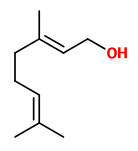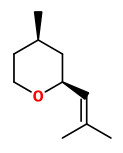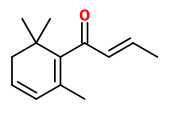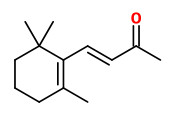Dies ist eine alte Version des Dokuments!
Rosa × damascena - Rosaceae - Damask rose, oil rose, Damaszener-Rose, Bulgarische Ölrose
„Rosa × damascena, more commonly known as the Damask rose, or sometimes as the Rose of Castile, is a rose hybrid, derived from Rosa gallica and Rosa moschata. Further DNA analysis has shown that a third species, Rosa fedtschenkoana, is associated with the Damask rose.“ http://en.wikipedia.org/wiki/Rosa_%C3%97_damascena
„In addition to the summer-flowering varieties, which probably descended from Rosa gallica and Rosa phenicia, there are twice flowering „autumn damask roses“. These are probably the result of interbreeding of Rosa gallica with Rosa moschata. An exploration of the genetic material of Rose de Resht suggests that the fall Damask roses have acquired their ability to bloom more often, at Rosa fedtschenkoana.“ http://de.wikipedia.org/wiki/Rosa_damascena
Main components of Bulgarian rose oil were (-)-citronellol (33.0%), geraniol (15.8%), nonadecane (9.1%), nerol (8.8%), cis-9-nonadecene (3.2%), heneicosane (3.0%), (-)-linalool (2.7%), and methyl eugenol (2.4%); minor constituents e.g. trans-nerolidol (0.19%), (E,E)-farnesol (1.37%), 2-phenylethanol (1.19%), geranylacetone (0.1%), (-)-cis-rose oxide (0.38%), (-)-trans rose oxide (0.17%), nerol oxide (0.09%), 1,8-cineole (0.003%), geranyl acetate (0.68%), citronellyl acetate (0.53%), menthyl acetate (1.35%).
The typical sweet, powerful honey aspect of rose oil is caused especially by ß-damascenone (0.2%) in combination with phenylethyl isobutyrate (0.1%), phenylethyl 2-methylbutanoate (0.05%), and benzyl tiglate (0.2%).
[Composition of essential oils : Part 7. Bulgarian oil of rose (Rosa Damascena mill.), Kovats E., J. Chromatography, 1987, 406, 185-222; (Paper prepared in 1972: „For reasons of industrial application of the results, it was not made free for publication…“)]
[Demole, E., Enggist, P., Säuberli, U., & Stoll, M. (1970). Structure et synthèse de la damascénone (triméthyl‐2, 6, 6‐trans‐crotonoyl‐1‐cyclohexadiène‐1, 3), constituant odorant de l'essence de rose bulgare (rosa damascena Mill. Helvetica Chimica Acta, 53(3), 541-551]
Pentane/dichloromethane extracts of Rosa x damascena petals showed phenylethanol as the main component (72-83%), followed by hydrocarbons (6-13.5%). Other components were geraniol (4.0-6.9%), nerol (1.4-3.7%), benzyl alcohol (1.1-2.5%), geranyl acetate (0.3-2.1%), and benzyl benzoat (0.2-0.6%). Nonanal/cis-rose oxide was not found or only present in traces.
[Characterization of 24 old garden roses from their volatile compositions., Antonelli, A., Fabbri, C., Giorgioni, M.E., Bazzocchi, R., Journal of Agricultural and Food Chemistry, 45(11), 1997, 4435-4439]
By monitoring the process of flower opening of the Bulgarian rose (Rosa damascena var. bulgarica), interesting changes of aroma ingredients were detected. 2-Phenylethanol, geraniol, citronellol, phenylethyl acetate, methyl benzoate, limonene, myrcene, ß-pinene and rose oxides were the main components of the flower scent observated by the headspace method.
[Aroma evolution during flower opening in Rosa damascena Mill. Oka, N., Ohishi, H., Hatano, T., Hornberger, M., Sakata, K., Watanabe, N., Zeitschrift für Naturforschung C, Vol.54(12), 1999, 889-895] http://zfn.mpdl.mpg.de/xtf/data/Reihe_C/54/ZNC-1999-54c-0889.pdf
„The minor constituents ß-damascenone and ß-ionone provide a significant majority of the odor contribution of Rosa damascena“
[Ohloff, 1990. cited by: Rosa damascena, A Review by John C. Leffingwell, Ph.D., Leffingwell Reports, Vol. 1, (No. 3) February, 2000] http://www.leffingwell.com/download/rose.pdf
Main components of Rosa damascena oil distilled under reduced pressure at various temperatures were citrollelol+nerol (27.8-35.1%), geraniol (15.3-26.5%), nonadecane (7.2-24.6%), 2-phenylethyl alcohol (3.8-9.6%), eugenol (1.5-2.0%), geranyl acetate (2.5-4.0%), heptadecane (1.4-6.0%), farnesol (1.5-5.4%) and 9-eicosene (1.5-5.0%).
[Essential oil composition of Damask rose (Rosa damascena Mill.) distilled under different pressures and temperatures., Babu, K.G., Singh, B., Joshi, V.P., Singh, V., Flavour and fragrance journal, 17(2), 2002, 136-140]
„The composition of the essential oil and the SPME-headspace volatiles of Rosa damascena L. (Rosaceae) from China were investigated by gas chromatographic-spectroscopic (GC-FID and GC-MS) and olfactoric methods to identify those compounds responsible for the characteristic, pleasant floral odour of these valuable, high-priced flower oils. Monoterpenes especially were found to be fragrance target compounds, while additionally some aliphatic hydrocarbons will have fixative effects and therefore are responsible for a longer-lasting odour impression (tested by olfactory evaluation after application to human skin) of this rose oil. The main compounds [concentration higher than 3.0%; calculated as %-peak area of GC-FID analyses using a polar (carbowax) column] of the 71 totally identified constituents of the two rose samples are as follows: Chinese rose oil: citronellol (30.71%), nonadecane (16.95%), geraniol (16.11%), nerol (7.57%), heneicosane (7.04%) and 9-eicosene (4.71%); and SPME-headspace of the Chinese rose oil: citronellol (37.05%), geraniol (18.62%), nerol (9.91%) and methyl eugenol (3.56%). A correlation of the identified constituents of the two rose oil samples with their single odour impressions is also given and the significant change of the composition of the SPME-headspace samples after rose oil application on human skin discussed.“
[Solid phase microextraction/gas chromatographic and olfactory analysis of the scent and fixative properties of the essential oil of Rosa damascena L. from China. Jirovetz, L., Buchbauer, G., Stoyanova, A., Balinova, A., Guangjiun, Z., Xihan, M., Flavour and fragrance journal, Vol. 20(1), 2005, 7-12]
There are also repeat-blooming cultivars of moss roses like R. × damascena ‘Quatre Saisons Blanc Mousseux’, which pedicel and calyx are covered with a green to brown mossy growth. The glandular („moss“) trichomes on leaves and sepals produce α-pinene and myrcene as most abundant compounds, leading to a balsamic scent.
[Caissard, Jean-Claude, et al. „Chemical and histochemical analysis of ‘Quatre Saisons Blanc Mousseux’, a moss rose of the Rosa× damascena group.“ Annals of botany 97.2 (2005): 231-238] https://academic.oup.com/aob/article/97/2/231/205860/Chemical-and-Histochem
Hydrosol from fresh R.damascena flowers ('rose water') contained 0.025-0.074% v/w of dissolved oil (extraction with dichloromethane), with 2-phenylethanol (67.4-72.4%) as major component along with other characteristic rose compounds like the rose oxides (tr-0.2%), citronellol (5.9-15.6%), damascenones (tr), nerol (1.2-9.2%), geraniol (2.1-16.8%), nonandecane (0.3-0.9%), nonadecene (0.1-0.7%), eicosane (tr-0.1%), heneicosane (tr-0.4%), eugenol (tr-0.4%), and methyl eugenol (0.2-0.4%).
[Agarwal, S. G., et al. „Chemical composition of rose water volatiles.“ Journal of Essential Oil Research 17.3 (2005): 265-267]
„Starting with cellular compartmentalization, we review the recent findings related to the formation of key aroma compounds in rose flowers. Metabolic pathways involved in the volatile formation such as the methylerythritol phosphate pathway, the shikimate pathway; and the formation of fatty acid and carotenoid derived volatiles are discussed. In addition, we summarize the knowledge about the enzymes involved in the formation of the different classes of volatile compounds.“
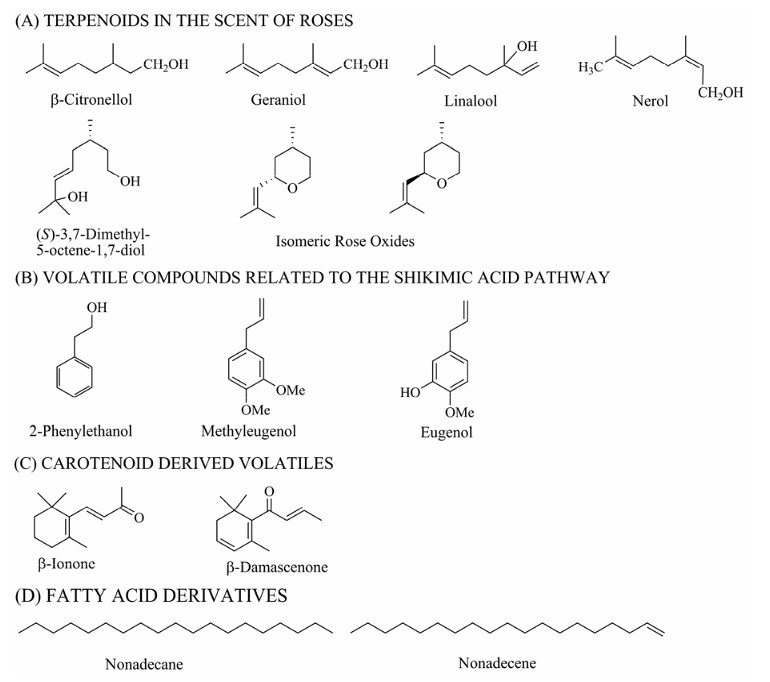
[Volatile constituents in the scent of roses., Watanabe, N., Susanne, B., Yang, Z., Sakai, M., Fleischmann, P., Floriculture and Ornamental Biotechnology, Vol.3(1), 2009, 89-97]
http://ir.lib.shizuoka.ac.jp/bitstream/10297/3636/1/090625001.pdf
Although ß-damascenone (0.03%), ß-damascone, (-)-rose oxide (0.09%, OU 4.1%) and nerol oxide (0.09%) account together for only slightly over 1% of Bulgarian rose oil, they are considered as its odoriferous principle. The olfactory impact (Odour Units, OU) of (-)-citronellol (38%, OU 4.3%) is much lower than that of ß-damascenone (0.03%, OU 70%) and ß-ionone (0.03%, OU 19.2%).
[Scent and Chemistry, Günther Ohloff, Wilhelm Pickenhagen, Philip Kraft, Wiley-VCH, 2012, 266-270]
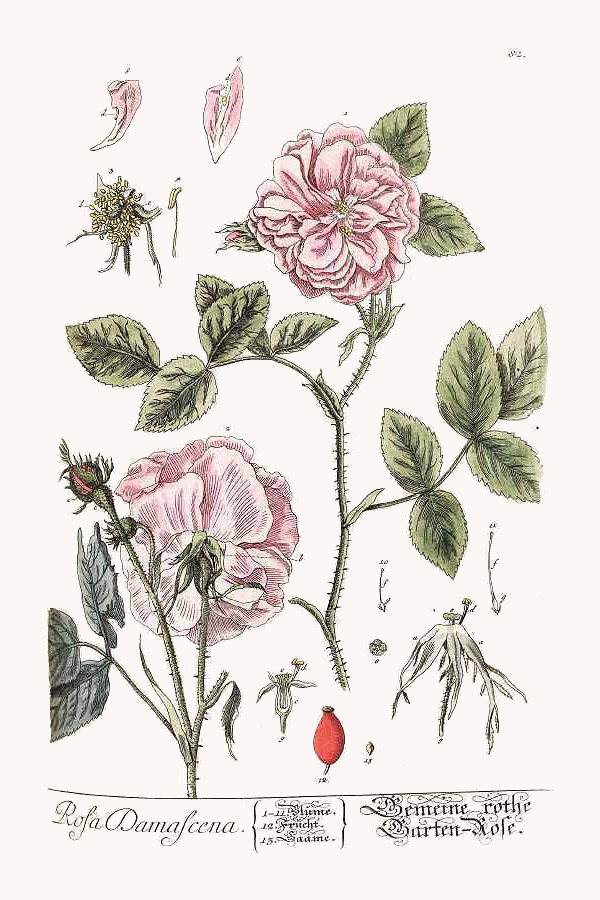
Blackwell, E., Herbarium Blackwellianum, vol.1, t.82 (1750)
http://plantgenera.org/species.php?id_species=1260951
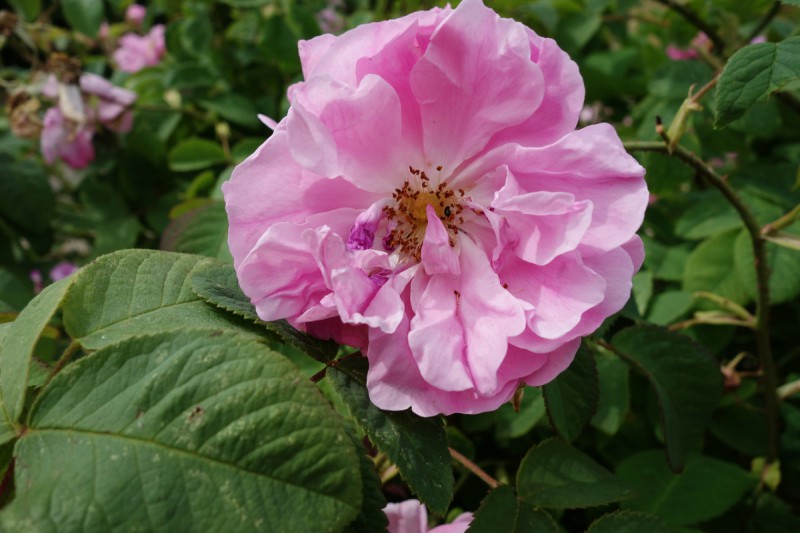
Rosa x damascena 'Trigintipetala', CC BY-SA 3.0, Author: Andreas Kraska


